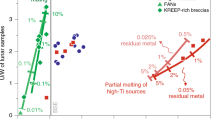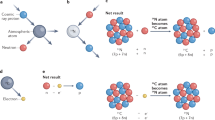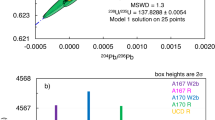Abstract
THE isotopic composition of lead changes with time due to radiogenic production from isotopes of uranium and thorium. Two lead isotopes are produced from uranium, 206Pb from 238U, and 207Pb from 235U. The paired U-Pb decay schemes are particularly useful since geochronological information can be derived even when there has been a chemical fractionation of U from Pb at some time during the history of the sample. For example, the 206Pb/204Pb and 207Pb/204Pb ratios can be measured in a galena (PbS) sample; by assuming that the parent material for the galena had suffered no chemical fractionation of U from Pb from the time of formation of the Earth until production of the galena, one can calculate a ‘model’ age of formation for the galena. This model is referred to as single stage growth of lead and can be characterised by a μ value [(238U/204Pb), as measured today] for the parent U-Pb system.
This is a preview of subscription content, access via your institution
Access options
Subscribe to this journal
Receive 51 print issues and online access
$199.00 per year
only $3.90 per issue
Buy this article
- Purchase on Springer Link
- Instant access to full article PDF
Prices may be subject to local taxes which are calculated during checkout
Similar content being viewed by others
References
Stanton, R. L., and Russell, R. D., Econ. Geol., 54, 588 (1959).
Stacey, J. S., Delevaux, M. E., and Ulrych, T. J., Earth planet. Sci. Lett., 6, 15 (1969).
Tatsumoto, M., Knight, R. J., and Allegre, C. J., Science, N.Y., 180, 1279 (1973).
Jaffey, A. H., Flynn, K. F., Glendenin, L. E., Bentley, W. C., and Essling, A. M., Phys. Rev., C4, 1889 (1971).
Russell, R. D., and Farquhar, R. M., Lead Isotopes in Geology (Interscience, London, 1960).
Oversby, V. M., Geochim. cosmochim. Acta, 34, 65 (1970).
Tilton, G. R., and Steiger, R. H., J. geophys. Res., 74, 2118 (1969).
Steiger, R. H., and Wasserburg, G. J., Geochim. cosmochim. Acta, 33, 1213 (1969).
Sinha, A. K., and Tilton, G. R., Geochim. cosmochim. Acta, 37, 1823 (1973).
Russell, R. D., Rev. Geophys., 10, 529 (1972).
Author information
Authors and Affiliations
Rights and permissions
About this article
Cite this article
OVERSBY, V. New look at the lead isotope growth curve. Nature 248, 132–133 (1974). https://doi.org/10.1038/248132a0
Received:
Issue Date:
DOI: https://doi.org/10.1038/248132a0
This article is cited by
-
Chemical and isotopic homogeneity of a 400 km long basic dyke in central West Greenland
Contributions to Mineralogy and Petrology (1986)
-
Age and origin of early Proterozoic dolerite dykes in South-West Greenland
Contributions to Mineralogy and Petrology (1985)
-
Lead isotopic composition and genesis of Phanerozoic metal deposits in China
Geochemistry (1982)
-
Structure and evolution of the Moon
Nature (1979)
-
Least radiogenic terrestrial lead from Isua, West Greenland
Nature (1978)
Comments
By submitting a comment you agree to abide by our Terms and Community Guidelines. If you find something abusive or that does not comply with our terms or guidelines please flag it as inappropriate.



